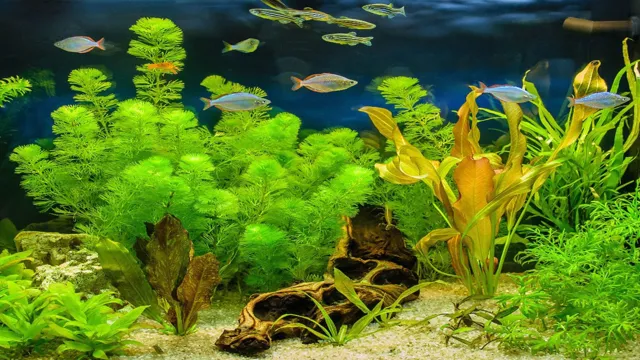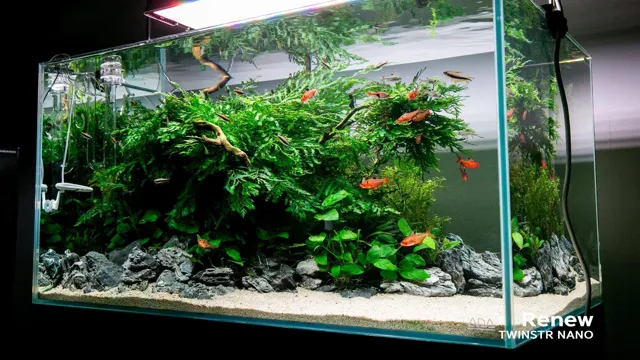If you’re fond of planting and want to add some greenery to your home or office, growing aquarium plants can be the perfect solution for you. They provide a calming and peaceful environment that can help improve your mood and productivity. However, some may think that owning fish is a prerequisite for enjoying the benefits of an aquarium.
But, that’s not the case! You can grow aquarium plants without fish and still receive the same benefits. It’s worth noting that growing aquarium plants without fish requires a little bit of research, effort, and patience. But with the right tools and knowledge, you can easily create a beautiful and thriving aquatic garden in your own home.
In this article, we will cover everything you need to know to get started with your aquascaping journey. Firstly, you need to choose the right type of plants for your aquarium. Some species require a lot of light, while others need minimal light to grow.
You should also consider the size of your tank, as some plants may grow too tall or bushy for smaller tanks. The most popular plants for aquariums are Anubias, Java Fern, and Amazon Sword, to name a few. Next, you need to create the right environment for your plants to grow in.
This means investing in a good quality substrate, fertilizers, and lighting. You can also add CO2 to your aquarium to support the growth of your plants. Make sure to regularly trim and prune your plants to prevent them from getting too big and taking over your aquarium.
Finally, it’s important to regularly maintain and clean your aquarium to keep your plants healthy and thriving. Regular water changes, filter maintenance, and algae control are all essential parts of aquarium maintenance. By following these tips, you can enjoy the beauty and benefits of an aquatic garden without the added responsibility of owning fish.
Why Grow Aquarium Plants without Fish?
Are you interested in growing aquarium plants but don’t want to keep fish? It’s possible to grow aquarium plants without fish, and many hobbyists do it successfully. The key is to provide the plants with the right conditions to thrive. This means ensuring adequate lighting, water filtration, and nutrients.
Plants in an aquarium without fish may require extra attention to ensure they receive the nutrients they need to grow healthy and strong. You can add fertilizers to the water to supplement the plant’s diet, and ensure the lighting is strong enough for photosynthesis. By providing the right environment, you can successfully grow aquarium plants without fish, creating a beautiful underwater garden for your enjoyment.
Benefits of Growing Plants without Fish in Aquariums
Aquariums are not just about fish. You can grow plants without fish in your aquarium and enjoy many benefits. Firstly, growing plants without fish keeps your tank much cleaner compared to a traditional fish tank.
When fish are not present, you don’t have to worry about overfeeding and excess food sinking to the bottom of the tank and decomposing. Besides, overfeeding leads to an increase in nitrogen levels in the water, which can be toxic to the fish. Secondly, Aquarium plants play a crucial role in maintaining a healthy and balanced ecosystem within the tank.
They absorb carbon dioxide and other harmful toxins, and release oxygen, which helps create a healthy environment for other aquatic life. Lastly, growing plants without fish is more economical in the long run because you don’t have to spend money on fish food, filters, and other accessories required for taking care of fish. In conclusion, growing plants without fish in aquariums is a practical and economical alternative that offers numerous benefits for aquatic plant enthusiasts.
You can enjoy a cleaner, healthier, and balanced environment without the worry of overfeeding fish or high maintenance costs. So, why not consider going fishless in your aquarium and experience the joys of gardening underwater.

Getting Started with Growing Aquarium Plants without Fish
If you’re interested in starting a planted aquarium, you might be wondering how to grow aquarium plants without fish. It’s actually fairly simple to get started – all you need are some plants, substrate, and a light source! First, choose the types of plants you want to grow. Some good options for beginners include java ferns, anubias, and mosses. (See Also: How to Keep Snakes and Lizard Aquarium: Essential Tips and Tricks for a Healthy Habitat)
Next, select a substrate that will provide the nutrients your plants need. You can use standard aquarium gravel, but some hobbyists prefer specialty substrates like flourite or eco-complete. Finally, install a light source that will provide appropriate levels of light for your plants.
LED lights are popular for planted aquariums because they’re energy-efficient and customizable. Once you have everything set up, it’s just a matter of regularly fertilizing your plants and trimming them as needed. With a little bit of patience and attention, you can create a thriving planted aquarium environment that doesn’t require any fish!
Choosing the Right Plants
When it comes to growing aquarium plants without fish, choosing the right plants is essential. You want to select plants that are hardy and can thrive in the conditions of your specific aquarium. Some popular options include Java ferns, Anubias, and Amazon swords.
Java ferns are low-maintenance and can survive in low light conditions. Anubias are great for beginner aquarists because they don’t require much care and can grow in low light as well. Amazon swords are a great option for larger aquariums as they can grow up to 20 inches tall and require moderate lighting.
Don’t forget to research the specific needs of each plant before adding it to your aquarium, as some may require special care such as CO2 injection or specific water parameters. Overall, choosing the right plants is the first step in creating a beautiful, thriving aquarium without fish.
Lighting Requirements for Plants in Aquariums
Growing aquarium plants without fish can be an exciting and satisfying experience, but it’s important to understand the lighting requirements of your plants. Light is essential for photosynthesis, the process by which plants produce their food. Without sufficient light, your plants may not grow or thrive.
The type of light you choose will depend on the specific needs of your plants. For low-light plants, such as Java fern and Anubias, you may only need a small LED light or natural sunlight. On the other hand, high-light plants like Amazon swords and Ludwigia require intense lighting that can be provided by metal halide or high-output LED fixtures.
It’s also important to note that the intensity and duration of light can affect the growth rate and color of your plants. Finding the right balance of light for your specific plant species is key to success in growing beautiful and healthy aquarium plants.
Substrate Considerations for Growing Plants without Fish
When it comes to growing aquarium plants without fish, choosing the right substrate is crucial. Unlike traditional fish tanks, where the fish waste provides essential nutrients for the plants, this particular type of aquarium requires substrate that can support plant growth without the presence of fish. Some popular options include coconut coir, vermiculite, perlite, and clay pebbles.
Each of these substrates has unique properties that make them ideal for growing aquarium plants, depending on the type of plant you wish to grow. For example, strong rooting plants like Anubias and Java fern do well in clay pebbles, while delicate plants like Cryptocoryne require a softer substrate like coconut coir. Choosing the right substrate for your aquarium plants is just as important as providing them with enough light and nutrients.
By picking the right substrate, you can help your aquatic plants thrive and add some vibrant greenery to your home. (See Also: How to make a virtual aquarium: A step-by-step guide to creating your own digital marine world)
Supplementing Nutrients for Plants in Aquariums
Supplementing Nutrients for Plants in Aquariums Growing aquarium plants without fish is a great way to add some greenery to your underwater world. However, it’s important to make sure your plants are getting the right nutrients they need to thrive. One way to ensure this is by supplementing their food with fertilizers.
It’s important to choose a fertilizer that’s specifically designed for aquatic plants and won’t harm any fish you may add later on. You can also add some organic matter, such as peat moss or worm castings, to your substrate to help with nutrient absorption. Another important factor to consider is lighting, as plants need ample light to photosynthesize and grow.
Investing in a good quality aquarium light can make all the difference in the success of your aquarium plants. By providing the necessary nutrients and lighting, you’ll be able to create a flourishing underwater garden that’s both beautiful and beneficial for your aquatic pets.
Maintenance for Growing Aquarium Plants without Fish
If you want to grow aquarium plants without fish, there are a few key things you need to keep in mind. First of all, you’ll need to provide your plants with the right amount and quality of light. This means investing in a good quality LED lighting system that will provide your plants with the right type of light for their needs.
Additionally, you’ll want to make sure that you’re dosing your aquarium regularly with the right nutrients. There are a variety of plant fertilizers available on the market, but you’ll want to make sure that you choose one that’s specifically formulated for aquatic plants. Finally, it’s important to keep the water chemistry stable.
This means testing your water regularly and adjusting it as needed to maintain stable pH, hardness, and other important water parameters. With the right care, attention, and equipment, you can grow beautiful and healthy aquarium plants without any fish.
Pruning and Propagating Aquarium Plants
If you’re growing aquarium plants without fish, it’s important to prune and propagate them regularly to maintain their health and growth. Pruning involves removing any dead or dying leaves, trimming back overgrown stems, and shaping the overall appearance of the plant. By doing this, you’ll be promoting new growth and preventing any potential diseases from spreading.
Propagating is also important for expanding your collection of plants and keeping your tank looking lush and full. You can do this by taking cuttings from healthy stems and rooting them in a separate container until they’re ready to be transplanted. Overall, regular maintenance for growing aquarium plants is essential for creating a thriving and beautiful aquatic environment.
Testing Water Parameters for Optimal Plant Growth
One of the crucial aspects of maintaining a healthy aquatic plant environment is to ensure that water parameters are optimal for plant growth. Testing the water quality regularly ensures that essential nutrients such as iron, potassium, and magnesium are present in the water to promote healthy plant growth. Ammonia and nitrite levels should be monitored as well since high levels of these compounds can harm the plants.
Carbon dioxide is also necessary for aquatic plants, and its levels in the water should be adequate for optimal growth. Testing the pH levels of the water is essential since the wrong pH can limit nutrient uptake or even kill the plants. When growing aquarium plants without fish, it’s vital to maintain and balance the water chemistry to ensure healthy and robust plant growth.
Nitrate levels, for instance, should be monitored and kept low since high levels of nitrates can lead to algae growth, which can compete with the plants for nutrients and light. Using fertilizers specifically designed for aquatic plants can supplement missing nutrients and promote plant growth. Overall, testing the water parameters and maintaining the correct water conditions is an essential part of keeping your aquatic plants healthy and vibrant without the need for fish.
Conclusion
Growing aquarium plants without fish is like having a delicious cake without the icing. While fish may provide nutrients for plant growth, there are many other ways to provide vital nutrition to your aquatic plant family. From adding fertilizers, providing proper lighting, and maintaining consistent water conditions, you can create a thriving aquatic environment that will make even the most fish-oriented hobbyists green with envy. (See Also: How to Put Fake Plants in an Aquarium: Tips and Tricks for a Stunning Underwater Landscape)
So if you’re ready to ditch the fish and dive into the world of plant care, get ready to grow your own underwater oasis and watch your plants flourish and bloom like never before!”
FAQs
What types of aquarium plants grow well without fish in the tank?
There are several types of aquarium plants that can thrive without the presence of fish, such as java fern, anubias, and java moss.
Can I use fertilizers to help my aquarium plants grow without fish?
Yes, fertilizers can be a great way to promote healthy growth in aquarium plants. However, it’s important to use the right type and amount of fertilizer, as too much can harm the plants and the fish.
Do I need special lighting to grow aquarium plants without fish?
Yes, because aquarium plants require a certain amount and wavelength of light to grow, it’s important to choose a light source that is appropriate for the types of plants you want to grow.
How often should I trim my aquarium plants if I’m not keeping fish?
The frequency of trimming will depend on the type of plants you have and how quickly they grow. In general, it’s a good idea to trim them once a month or as needed to keep them from getting too long and tangled.
Are there any specific tips for growing aquarium plants without fish?
Yes, some tips include choosing the right substrate for your plants, providing adequate ventilation and circulation, and avoiding overfeeding the plants with fertilizer or nutrients.
Can I add invertebrates to my aquarium if I’m only growing plants?
Yes, many invertebrates like snails, shrimp, and crayfish can coexist peacefully with aquarium plants and help keep the tank clean and healthy.
Should I use live or artificial plants if I’m not keeping fish in my aquarium?
This ultimately depends on personal preference, but live plants tend to be more beneficial for the health of the tank and require more care and attention than artificial plants.







